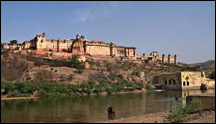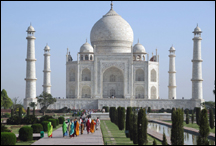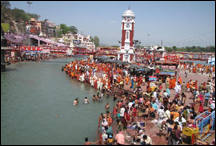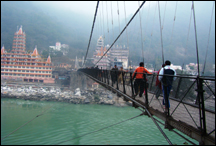




Delhi (also known as the National Capital Territory of India) is a metropolitan region in India. With a population of 22 million in 2011, it is the world's  second most populous city and the largest city in India in terms of area.
second most populous city and the largest city in India in terms of area.
Delhi is a city that bridges two different worlds. Old Delhi, once the capital of Islamic India, is a labyrinth of narrow lanes lined with crumbling havelis and formidable mosques. In contrast, the imperial city of New Delhi created by the British Raj is composed of spacious, tree-lined avenues and imposing government buildings. The city's importance lies not just in its past glory as the seat of empires and magnificent monuments, but also in the rich and diverse cultures.
Jaipur, India
Jaipur is the capital and largest city of the Indian state of Rajasthan in Northern India. It was founded on 18 November 1727 by Maharaja Sawai Jai Singh II, the ruler of Amber, after whom the city has been named. The city today has a population of 3.1 million. Jaipur is known as the Pink City of India.
Singh II, the ruler of Amber, after whom the city has been named. The city today has a population of 3.1 million. Jaipur is known as the Pink City of India.
Jaipur is a major tourist destination in India. Jaipur has a number of forts and monuments like Hawa Mahal, Amer Fort, Jaigarh Fort, Nahargarh Fort, City Palace, Jantar Mantar, Jal Mahal, Rambagh Palace, Albert Hall Museum.
Agra, India
Agra, the former capital of Hindustan, is a city on the banks of the river Yamuna in the northern state of Uttar Pradesh, India. It is 363 kilometres west of the state capital, Lucknow, 200 kilometres south of the national capital New Delhi and 125 kilometres north of Gwalior.
The city is mentioned in the epic Mahabharata, where it was called Agrevana ("the border of the forest"). Though Agra's history is largely recognised with Mughal Empire, the place was established much before it and has linkages since Mahabharat period and Mahirshi Angira in 1000 BC. It is generally accepted that Sultan Sikandar Lodī, the Ruler of the Delhi Sultanate founded Agra in the year 1504.
The Taj Mahal is one of the most famous buildings in the world, the mausoleum of Shah Jahan's favourite wife, Mumtaz Mahal. It is one of the New Seven Wonders of the world, and one of the three World Heritage Sites in Agra.
Kerala, India
Kerala, regionally referred to as Keralam, is a state in the south-west region of India on the Malabar coast. It was formed on 1 November 1956 as per the States Reorganisation Act by combining various Malayalam-speaking regions.
According to Hindu mythology, the land of Kerala was recovered from the sea by Parasurama, an avatar of Vishnu; hence Kerala is also called Parasurama Kshetram ("The Land of Parasurama").
The state is wedged between the Lakshadweep Sea and the Western Ghats. Geographically, Kerala can be divided into three climatically distinct regions: the eastern highlands; rugged and cool mountainous terrain, the central mid-lands; rolling hills, and the western lowlands; coastal plains. The eastern region of Kerala consists of high mountains, gorges and deep-cut valleys immediately west of the Western Ghats' rain shadow.
The culture of Kerala is composite and cosmopolitan in nature and it's an integral part of Indian culture. It has been elaborated through centuries of contact with neighboring and overseas cultures. Onam (Malayalam) is a harvest festival celebrated by the people of Kerala, India. Kerala has a large number of Hindu temples.
Haridwar, India
Haridwar also spelled Hardwar is an ancient city and municipality in the Haridwar district of Uttarakhand, India. The River Ganges, after flowing for 253 kilometres (157 mi) from its source at Gaumukh at the edge of the Gangotri Glacier, enters the Indo-Gangetic Plains of North India for the first time at Haridwar, which gave the city its ancient name, Gangadwara.
Haridwar, which gave the city its ancient name, Gangadwara.
Haridwar is an ancient pilgrimage site, held in reverence for centuries. Several temples and ashrams dot this town and a visit to Haridwar is like stepping into a totally different world. Kapilastaan, a spot in Haridwar is pointed to as Kapila's hermitage. Haridwar was once known as Gangadwara.
The five sacred bathing spots in Haridwar are Gangadwara, Kankhal, Nila Parvata, Bilwa Theertha and Kusavarta. The main ghat at Haridwar is known as Hari-ki-Pairi (known for a footprint of Vishnu on a stone in a wall). Nearby is the Gangadwara temple, the most important of the several temples that dot this town.
Rishikesh, India
Rishikesh is a city, municipal board and a tehsil in Dehradun district of the Indian state, Uttarakhand. Located in the foothills of the Himalayas in northern India, it is known as The Gateway to the Garhwal Himalayas. Rishikesh is surrounded by three other districts namely Tehri Garhwal, Pauri  Garhwal and Haridwar.
Garhwal and Haridwar.
Rishikesh has been a part of the legendary 'Kedarkhand' (the present day Garhwal). Legends state that Lord Rama did penance here for killing Ravana, the demon king of Lanka; and Lakshmana, his younger brother, crossed the river Ganges, at a point, where the present 'Lakshman Jhula' bridge stands today, using a jute rope bridge. Several temples, ancient as well as new, can be found along the banks of the Ganges in Rishikesh. Shatrughan Temple, Bharat Mandir, Laxman Temple are the ancient temples established by Adi Sancharacharya. Shatrughan Temple is located near Ram Jhula and Laxman Mandir is near to Laxman Jhula (Laxman Bridge).
The Tehri Dam is just 80 km uphill on the way to Gangotri. Rishikesh is the starting point for travelling to the four Chota Char Dham pilgrimage places — Badrinath, Kedarnath, Gangotri, and Yamunotri. Rishikesh is also famous for ayurvedic treatments.![]()
